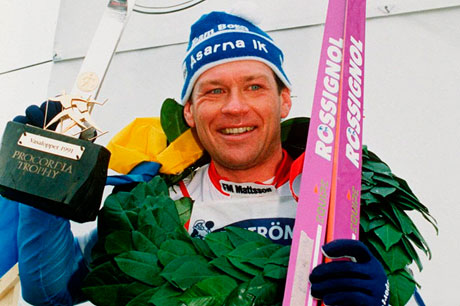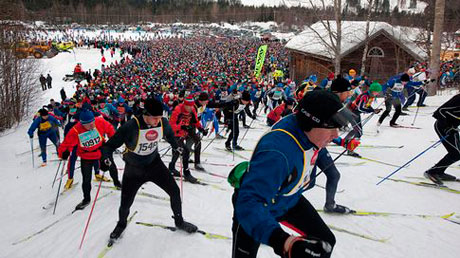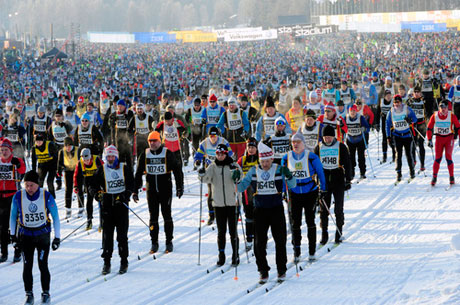CROSS-COUNTRY SKI TIPS. Although Jan Ottosson is a double Olympic cross-country skiing champion (relay 1984 and 1988) and has accumulated a heap of Swedish Championship gold medals, he is probably most known for his four Vasaloppet victories (1989, 1991, 1992 and 1994). After his skiing career, Jan worked for several years on the waxing staff of the Swedish national team.

Jan Bo Ottosson (SWE), winner of the Vasaloppet 1991. Photo: Jan Collsiöö/Scanpix
Today he works as a ski instructor for young elite skiers. In addition, during the winter season he hosts ski camps for leisure skiers aiming to ski the 90K Vasaloppet. On the following pages he shares his knowledge about how to train for races such as Birkebeinerrennet, Dolomitenlauf, König Ludwig Lauf, Marcialonga, La Transjurassienne and Vasaloppet.

Vasaloppet 2010, Photo: ULF PALM/SCANPIX
Train on a regular basis

Vasaloppet 2012, Photo: Nisse Schmidt
If you want to ski a long-distance ski race in the best possible manner, you must train on a regular basis. If you work full time and can train maximum 3-5 times per week, you should try to do a longer, low-intensity workout during the weekend and 2-4 more intense workouts during the week. The long weekend practice is a base workout that enhances endurance and improves your fat burning capacity. Since this workout is carried out at a slow speed, you have a great opportunity to improve your technique. If there is no snow where you are at and you have no roller skis, running and cycling are great alternatives for this kind of training.
The more intense workouts could be interval workouts or distance workouts that last for approximately an hour. The intensity level should be slightly above the pace you aim to ski at during the race. One of these workouts could also be used to improve your general strength, preferably the strength in your back, stomach, arms and shoulders.
If you have no possibility to ski or roller ski, an expander rope is a great investment. It will help you strengthen the muscles in your upper body that are needed for cross-country skiing. A great way to give your training an extra boost, is to run in unbeaten terrain once a week. It will quickly improve your condition, make you supple and strengthen both your legs and your upper body, which makes you a stronger skier.
Example of a training schedule for leisure skiers planning to ski Vasaloppet or similar ski races
THE GET-IN-SHAPE PERIOD, 4-12 weeks
If you are already in good shape, proceed to Training period 1.
Mon: Easy cycling or jogging, skiing if possible, 45 min.
Tue: Strength training: entire body.
Wed: Rest.
Thur: Jogging or running with poles, skiing if possible, medium intensity, 45 min.
Fri: Rest.
Sat: Easy jogging or running with poles, skiing if possible, 60-90 min.
Sun: Rest.
TRAINING PERIOD 1, 8 weeks
Mon: Easy workout: skiing/roller skiing/pole walking/running/cycling, 45-90 min.
Tue: Strength training: stomach/back.
Wed: Skiing/roller skiing/pole walking/running/cycling: warming up 15 min, 80% of max for 20-40 min, cooling down 15 min.
Thur: Rest.
Fri: Strength training: stomach/back.
Sat: Easy workout: skiing/roller skiing/pole walking/running/cycling, 45-90 min.
Sun: Rest.
TRAINING PERIOD 2, 8 weeks
Mon: Easy workout: ski without poles, exaggerate movements and think technique, 60 min. Ski slowly!
Tue: Strength training on skis: double pole uphill in intervals lasting 1 min.
Wed: Rest.
Thur: Skiing 80%: warming up 15 min, ski 80% of max for 20-40 min, cooling down 15 min.
Fri: Strength training: stomach/back.
Sat: Easy workout: ski without poles, exaggerate movements and think technique, 90 min. Ski slowly!
Sun: Rest.
PEAKING AND TAPERING PERIOD, 3 weeks
Week 1
Mon: Rest.
Tue: A shorter workout with lots of double poling, 60 min.
Wed: Very slow workout, 90 min.
Thur: Tough, shorter workout with some double-pole sprints, 60 min.
Fri: Rest.
Sat: Short, easy workout, 60 min.
Sun: Competition or competition-like workout.
Week 2
Mon: Rest.
Tue: Rest.
Wed: A shorter workout with lots of double poling, 60 min.
Thur: Very slow workout, 90 min.
Fri: Tough, shorter workout with some double-pole sprints, 60 min.
Sat: Very slow workout, 90 min.
Sun: Competition or competition-like workout.
Week 3
Mon: Rest.
Tue: Short, easy workout, 45 min.
Wed: Easy workout, end with 10 intervals at maximum speed, 1 min skiing – 3 min rest, double pole/diagonal.
Thur: Rest.
Fri: Short, easy (!) workout, 45 min.
Sat: Short, easy (!) workout, 45 min.
Sun: Day of competition!
TIPS
• Bring some food (a thermos and a sandwich) to the start area. Make sure your energy levels are maximized as close to the start as possible.
• Bring some ski wax with you during the race. Check out the weather forecast.
• Drink and eat energy drinks and bars during the entire race. Begin as soon after the start as possible.
• Start out easily and speed up slowly until you reach your desired pace.
Good luck!
by CRAFT
www.craft.se

|


